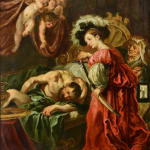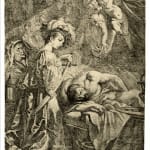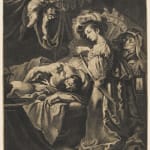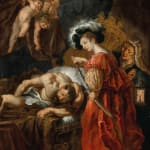Open a larger version of the following image in a popup:


Cornelis Schut, Judith & Holofernes, etching on laid paper.
British Museum, object no. 2007,7078.1.
Open a larger version of the following image in a popup:


Jan Witdoeck after Cornelis Schut, Judith and Holofernes, 1633, etching on laid paper.
Philadelphia Museum of Art, accession no. 1985-52-16512.
Open a larger version of the following image in a popup:


Cornelis Schut, Judith and Holofernes, oil on copper.
Private collection, Antwerp.
Cornelis Schut (Antwerp 1597 - 1655)
Judith and Holofernes
oil on copper
22,2 x 17 cm
Further images
Cornelis Schut was born in Antwerp in 1597. After probably training and working for a few years in the workshop of Peter Paul Rubens, he became a master of the...
Cornelis Schut was born in Antwerp in 1597. After probably training and working for a few years in the workshop of Peter Paul Rubens, he became a master of the Antwerp Guild of Saint Luke in 1618. Between 1624 and 1627 he lived in Rome, where he was one of the early members of the Bentvueghels, a local society of Flemish and Dutch artists. His nickname or “bentnaam” was ‘Brootsaken’ (‘bread bags’). In 1627-1628 the artist was in Florence, where he designed tapestries for the Arrazeria Medicea, the tapestry factory founded by Cosimo I de Medici. In the early 1630’s he returned to Antwerp.
In 1635 Schut collaborated on the decorations for the Royal Entry of the Cardinal-Infante Ferdinand in Antwerp, a project that was overseen by his former master Rubens. That same year, he was also commissioned to work on preparations for the Joyous Entry in Ghent. Schut collaborated on many other projects, alongside artists such as Gaspar de Crayer and Theodoor Rombouts. He painted the figures in many of Jan van Kessel’s flower garlands. Schut was regularly commissioned for altarpieces in churches and monasteries across the Southern Netherlands, but also further afield, such as in Cologne. In the Antwerp cathedral of Our Lady he painted the ceiling decoration of the dome, which depicts the Assumption of Mary; for the Antwerp Jesuit church he painted one of the four alternating altarpieces, the Ascension of Mary.
Stylistically, Schut was influenced by his contemporary Abraham Janssens, as well as by several Italian painters, such as Guercino and Guido Reni. Although he certainly borrowed motifs and stylistic elements from his master Rubens, the latter’s stylistic influence on Schut varied throughout Schut’s career, being strongest when Schut was in Antwerp for a longer period of time. The current copper depicting the Jewish heroine Judith, drawing the sword of the sleeping Assyrian General Holofernes in order to behead him, set beneath a tent awning supported by putti and accompanied by Judith’s maidservant, is a recently rediscovered work by Cornelis Schut.
The attribution to Schut is supported by the existence of two prints. The first is an undated etching, in reverse of the painting, which is signed ‘CSchut’ and may have been etched by Schut himself (fig. 1), and secondly through an engraving, which shares the scheme of the present work, by Jan Witdoeck, published by Johannes Meyssens in Antwerp in 1633, and which identifies Schut as the inventor of the composition: ‘Cor Schut invenit’ (fig. 2). In the present picture, the delicate handling of the flesh of the sleeping Holofernes and the wizened face of the maidservant, along with the rapidly executed drapery of the figures, all point to a dating soon after Schut’s return from Italy. Interestingly, another, slightly larger (32 x 25 cm) autograph version of the present picture (private collection, Antwerp; fig. 3) was handled by the gallery in 2023, when it was included in the exhibition Cornelis Schut, Pittore Fiammingo.




